Don't overlook the most important tip if you want to learn how to make an easy Horiatiko psomi like a true Greek! Also known as Greek village bread or country bread, this traditional loaf holds an indispensable place on every Greek table. It will surely earn a place among your favorite bread recipes.
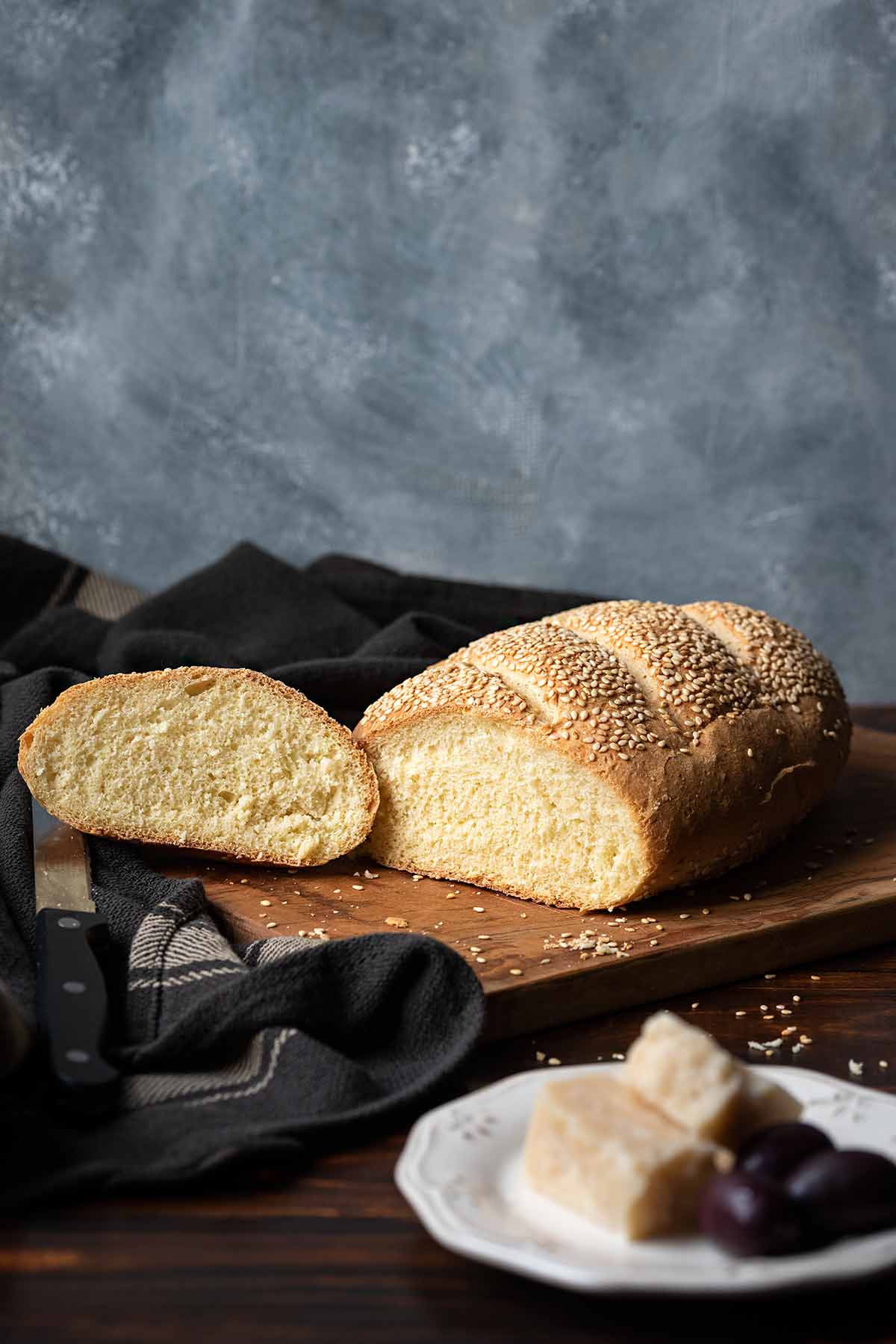
Jump to:
Bread is one of the most important things in Greek culture (and cuisine) and every bakery here in Greece fills its shelves with as many loaves as possible from early morning.
Though every region has it's own variations, the most common types are white bread, whole wheat bread and village bread (Horiatiko psomi). Horiatiko means "from a village" and psomi is the Greek word for bread.
Horiatiko psomi is made with Durum wheat a type of hard wheat cultivated in the Mediterranean region for many years. Because durum wheat flour has yellow color it gives bread a distinctive yellow hue (and delicious flavor).
This type of flour (sometimes called semolina flour) is also traditionally used to make Italian pasta which is also more yellow than other types of pasta.
If you like bread recipes and enjoy baking bread as much as I do, you should also check this Greek Artos recipe (monastery bread), a fluffy sweet aromatic bread served during religious holidays, this homemade Greek pita bread which used to make the Greek gyros (or souvlaki), and this Greek koulouri recipe covered with sesame seeds (koulouri is similar to a bagel or Turkish Simit).
😍 Why I love this bread recipe
These are some of the reasons why I love this
✓ Easy: Using dry yeast makes the procedure so much easier!
✓ Delicious: It tastes amazing. If you toast a slice and drizzle it with some extra virgin olive oil and a bit of oregano it's even better!
✓ Traditional: Preserving traditional Greek recipes was one of the reasons I started this blog, so I'm really happy to post this Greek village bread recipe here.
📋 Greek Village Bread Ingredients
For this Greek bread recipe you'll need the following ingredients:
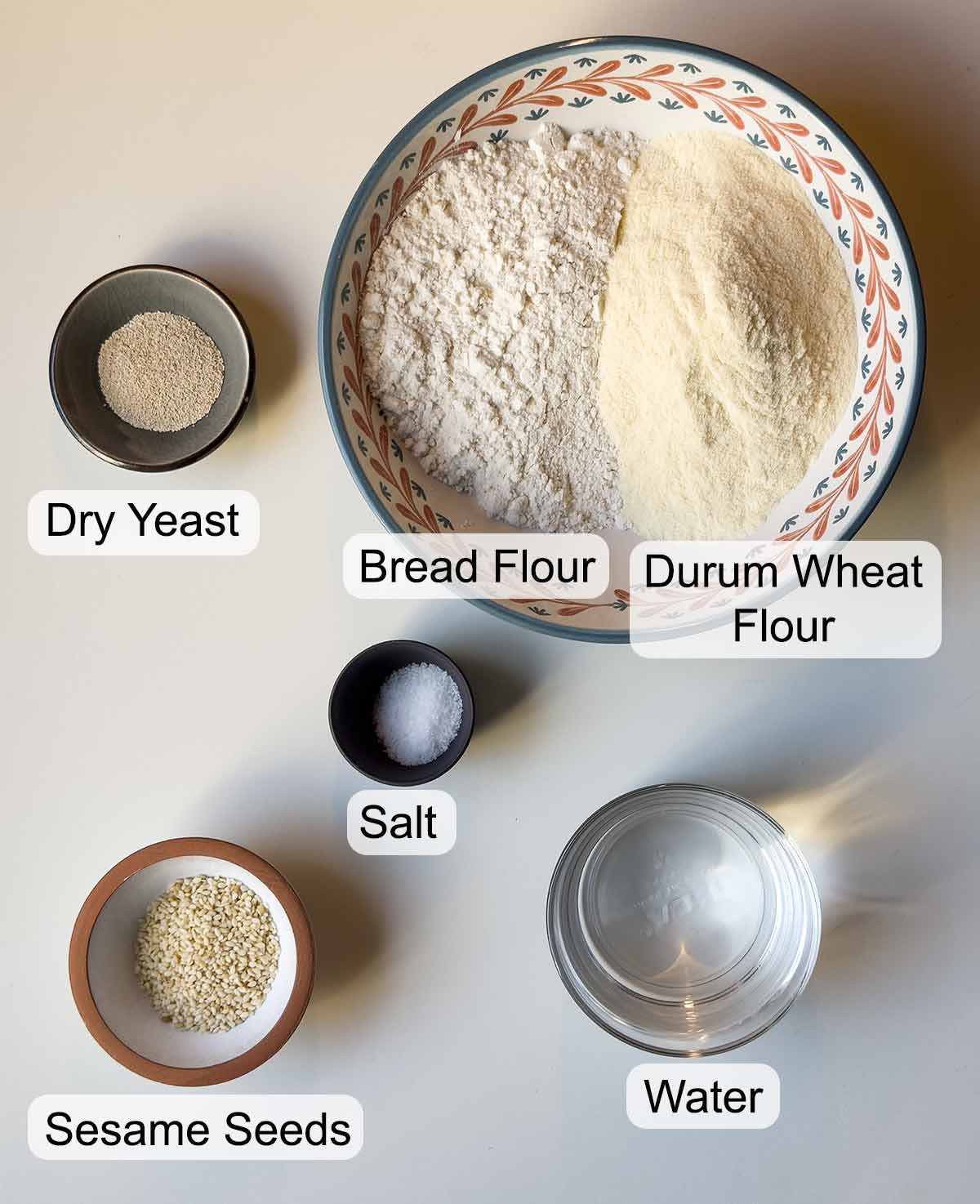
Durum wheat flour: In Greece it's also known as yellow flour (not to be confused with corn flour though) or "alevri zimoto" which means flour for kneading, but you may also know it as semola flour. It comes from hard wheat (Triticum durum). If you can't find Durum wheat flour you can make this recipe with ordinary bread flour (if it's stone-ground the better).
Bread flour: This is flour from soft wheat (Triticum aestivum) with high protein content (around 12-13%).
Sesame seeds: They're optional, and can be hulled or whole.
The thing that distinguishes Greek village bread is the flour. It must be from Durum wheat, which has been cultivated in ancient Greece and the Mediterranean region for many years. It has a yellowish color and delicious taste.
The information about the wheat is mainly derived from mills.gr (article in Greek). You can also find useful information in the article Durum wheat sourdough bread (by greekchemistinthekitchen.com)
🥣 Substitutions - Variations
Sourdough: If you're a fan of sourdough bread, you can omit the dry yeast and use sourdough starter to make it a sourdough Horiatiko bread.
Fresh yeast: Instead of dry yeast you can also use 0.9 oz (25 grams) fresh yeast.
Various shapes: Instead of a loaf you can give Horiatiko bread a round or oval shape, or even shape it like a large donut (with a hole in the middle).
🔪 How to Make Horiatiko Bread
Follow this easy step-by-step guide to make the best Horiatiko psomi.
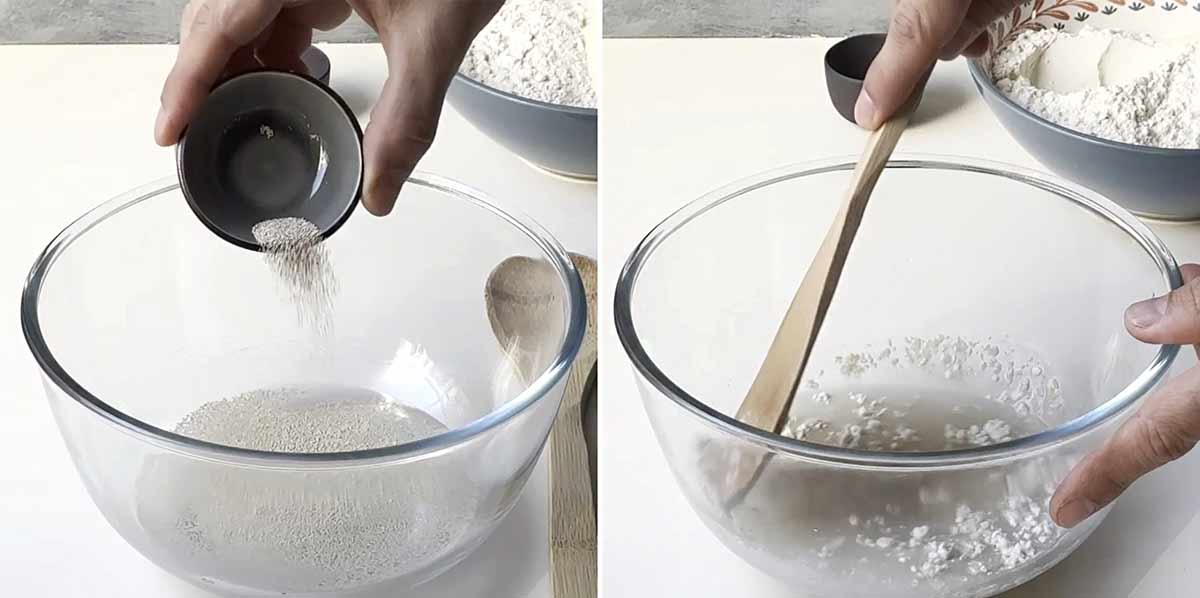
1. Add the water to a large bowl and sprinkle over the dry yeast. Sprinkle 1-2 tablespoons of the flour (so that the yeast has something to eat) and set aside in a warm place for 10-15 minutes. After that you should see some activity going on like small bubbles or foam.
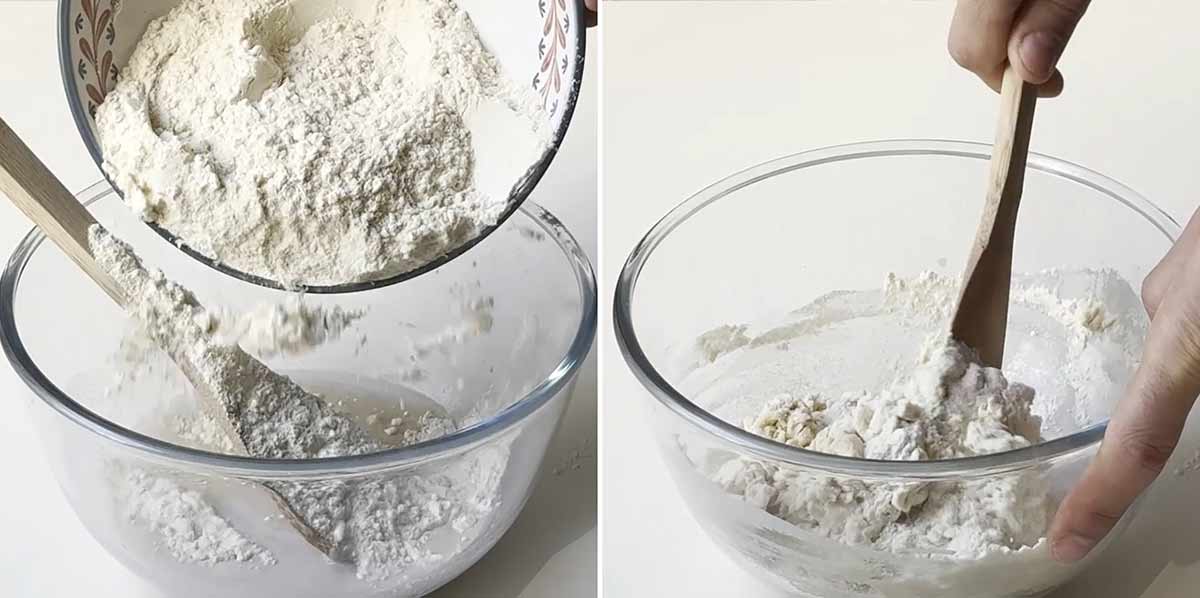
2. Add the flour and the salt and stir with a wooden spoon until all of the flour is hydrated (the mixture may look dry at first but that's normal). No need to knead at this stage, just cover the bowl with plastic wrap or a wet towel and set aside in a warm place until tripled in volume (about 1 hour).
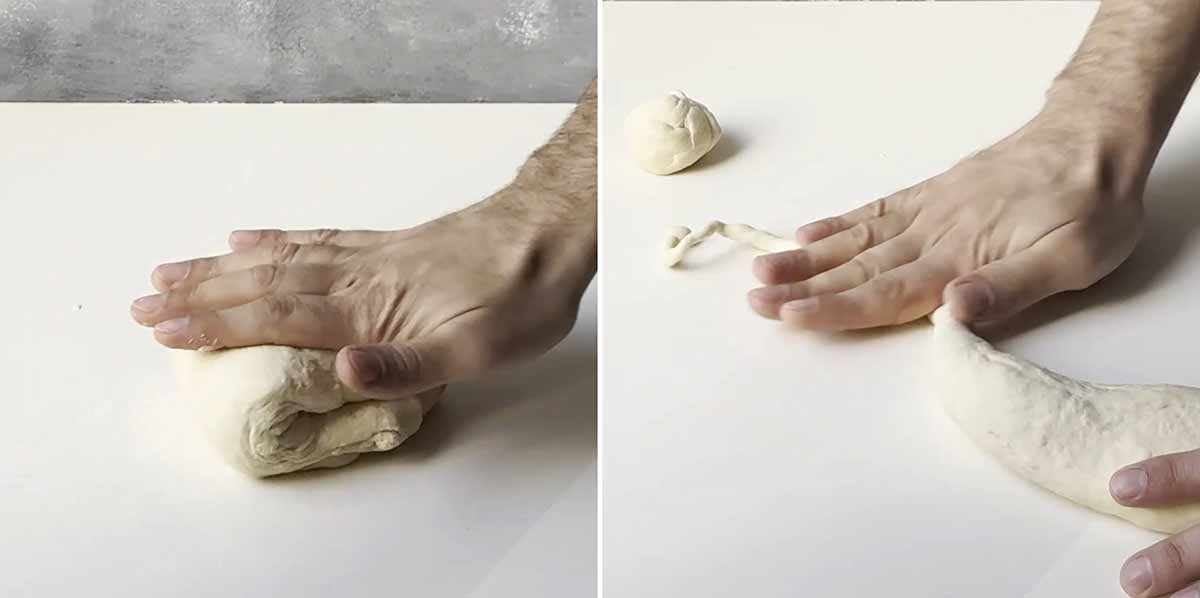
3. Transfer the bread dough to your kitchen counter and knead for 5 minutes until you get a soft, smooth and pliable dough.
I like to take small portions of dough and rub them against the surface of my kitchen counter to form thin strings. I've found that this method helps to develop the gluten of the flour and makes the dough very smooth.
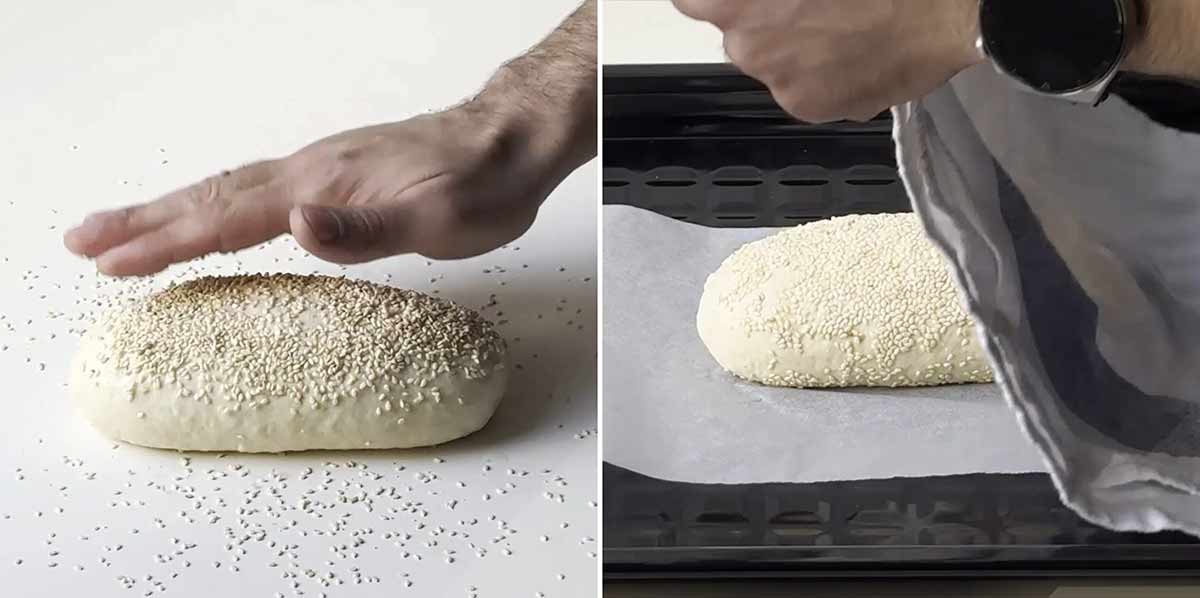
4. After kneading, roll the dough into a ball and shape it into one large or two smaller loaves (please note that in the photos and video I made half a recipe so I made just one small loaf). Optionally, you can brush the loaf with some water and roll it over some sesame seeds.
Cover the loaf with a dump towel and let it rise until almost doubled in volume (about 30 minutes). This is a good time to preheat your oven.
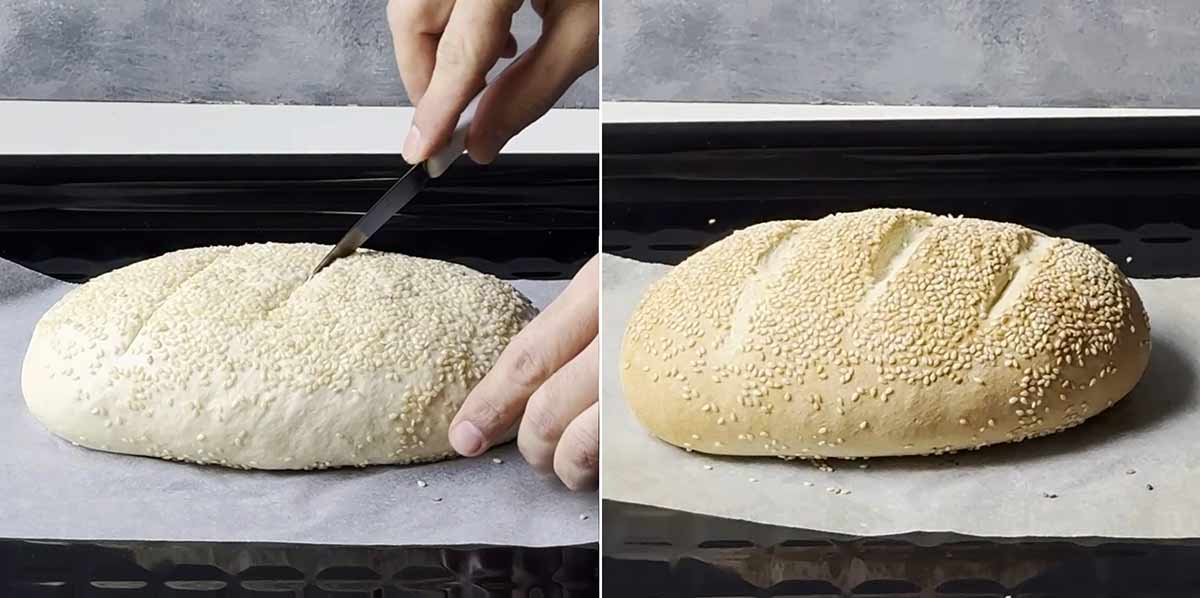
5. Once the bread has doubled in volume, score it with a sharp knife and brush it with some water (this makes the crust more crispy).
Bake it in the oven until golden brown. Transfer on a cooling rack and let it come to room temperature before slicing.
👨🍳 Expert Tips
✤ More flavor - slow maturation: If you're an experienced baker, you can reduce the amount of yeast to ½ teaspoon, let the bread dough rise in the refrigerator overnight, and bake the bread the next day.
✤ Greek Horiatiko bread is made with flour, water, salt, and yeast (or sourdough). Sometimes a little bit of olive oil can be added because it makes it more moist. No milk, butter or eggs are used in the traditional recipe!
✤ Salt can kill the yeast if it comes in direct contact with it, that's why it is usually mixed with the flour.
✤ Greek way to check when the bread is fully baked: Take it out of the oven and knock the bottom of the bread with your knuckles (handle it using chicken gloves or a a kitchen towel, because it's hot). If you hear a hollow sound, then the bread is baked.
💭 FAQs
The Greek name for bread is "psomi". In ancient Greek it is "artos" a name that is also used today in some cases.
In Greece there are many types of bread, each having it's own name, with the most popular being:
Horiatiko: Greek vilage bread or country bread
Krithino: A type of barley bread used to make Dakos (rusks).
Pita: A type of flatbread used as a wrap to make gyros.
Lagana (sesame bread): A Greek traditional flatbread made on Clean Monday.
Olikis Alesis: A dark colored bread made with whole wheat flour.
Tsoureki: A sweet bread made during Easter. Sometimes it is adorned with a dyed egg.
Prosforo: A white bread made as an offering for church.
Artos (Artoklasia): A lightly sweet bread offered in certain religious ceremonies.
Dakos or Kritharokouloura: A hard barley rusk usually soaked with water before consumption.
Greek bread tastes different mainly because of the flour used. This type of flour comes from durum wheat (semola or semolina flour) and has a distinctive yellow color. It is considered more tasty than the flour coming from soft wheat.
What to serve with:
Greek village bread is an integral part of every Greek table. It accompanies every food, and especially foods without meat and pasta, like this Greek green bean stew and this Greek lentil soup (Fakes). Other dishes you can't have without a slice of Horiatiko psomi are:
- Taramasalata (Greek fish roe dip)
- Greek Tzatziki
- Hummus
- Baba Ganoush (smoked eggplant dip)
- Labneh (fresh cheese made from Greek yogurt)
🍳 More Bread Recipes
If you tried this Greek village bread recipe or any other recipe on my website, please leave a 🌟 star rating and let me know how it went in the 📝 comments below. I love hearing from you!
🎥Recipe Video
Please note that in the following video I make half a recipe.
📖 Recipe
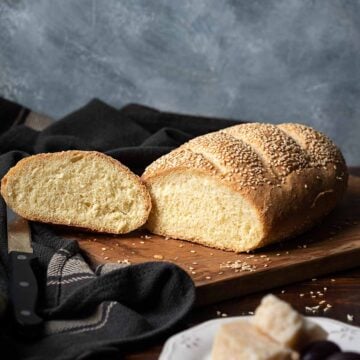
Greek Village Bread Recipe (Horiatiko psomi) 🥖
Ingredients
- 8.8 oz (250 g) bread flour (see notes for cup measurements)
- 8.8 oz (250 g) durum wheat flour (a.k.a. semola - see notes)
- 10.6 oz (300 g) water (lukewarm)
- 2 teaspoons dry yeast
- 1 ½ teaspoon fine sea salt
- 2 tablespoons sesame seeds (optional)
Instructions
- Proof the yeast: Add the water to a large bowl and sprinkle the dry yeast. Sprinkle 1-2 tablespoons of the flour (so that the yeast has something to eat) and set aside in a warm place for 10-15 minutes. After that time you should see some activity going on like small bubbles or foam.
- Make the bread dough: Add the flour and the salt and stir with a wooden spoon until all of the flour is hydrated (the mixture may look dry at first but that's normal).No need to knead at this stage, just cover the bowl with plastic wrap or a wet towel and set aside in a warm place until tripled in volume (about 1 hour).
- Knead: Transfer the bread dough to your kitchen counter and knead for 5 minutes until you get a soft, smooth and pliable dough.I like to take small portions of dough and rub them against the surface of my counter to form thin strings. I've found that this method helps to develop the gluten of the flour and makes the dough very smooth.
- Shape the bread: After kneading, roll the dough into a ball and shape it into one large or two smaller loaves (please note that in the photos and video I made half a recipe so I made just one small loaf). Optionally, you can brush the loaf with some water and roll it over some sesame seeds.Cover the loaf with a dump towel and let it rise until almost doubled in volume (about 30 minutes).
- Preheat your oven to 390°F (200°C).
- Bake: Once the bread has doubled in volume, score it with a sharp knife and brush it with some water (this makes the crust more crispy).Bake it in the oven until golden brown and the crust seems crispy (about 30-35 minutes if you make two small loaves or 50-55 minutes for one large loaf).Transfer on a cooling rack and let it come to room temperature before slicing.
Notes
- Durum wheat flour is a type of hard wheat flour with yellow color. In Greek it is often named as yellow flour or "alevri zimoto". You may also know it as semola flour (but it's not the same as semolina, because it is much finer).
- This recipe will also work with durum wheat flour only or with normal bread flour only.
- This is a 60% hydration recipe which will give you an easy to work with, not sticky dough. If by any chance the dough becomes sticky during kneading, just add a sprinkle of flour.
- Salt plays a big role in the taste of the bread. Here it is approximately 9-10 grams (1 ½ teaspoon) for the basic recipe, which is 1.25% in total. This is not too much neither too little. Feel free to adjust the quantity according to your taste.
- Temperature will affect the time that the dough and the bread need to rise. I place it in a closed oven set at 95°F (35°C).
- 4.4 oz (125 grams) durum wheat flour = ¾ cups (approximately)
- 4.4 oz (125 grams) bread flour = 1 cup





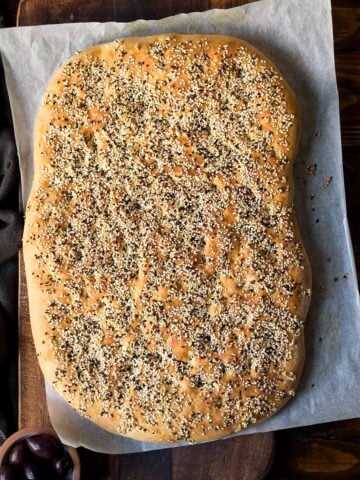
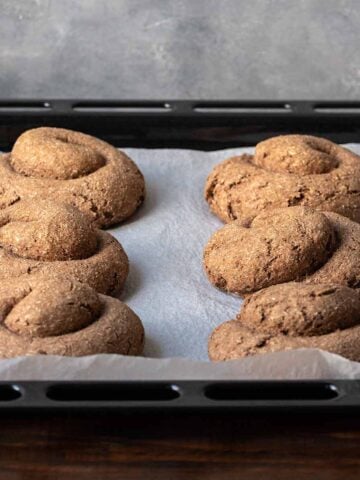


Priya says
I enjoyed reading about the difference that Greek Horiatiko has with other types of bread. As I didn't have any yellow flour, I made it with my ordinary bread flour. The dough was very easy to knead and the bread came out delicious. Thanks for the recipe!
Makos says
That's great Priya, happy baking!
Paul M says
I used some fine semolina and bread flour because I couldn't find the yellow flour and it turned out delicious. Very easy recipe, and it reminded me of the bread I ate during my vacations in Greece.
Makos says
Hi Paul, thanks for letting me know, bon apetit!